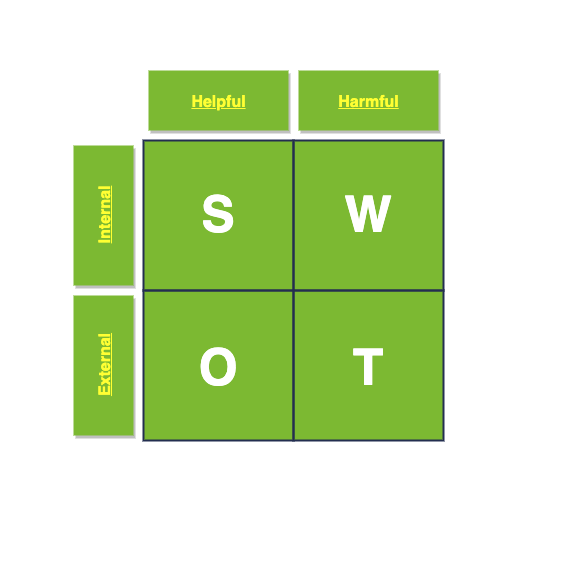What Is SWOT Analysis and How to Do It Correctly
As part of analytical operations, several different tools and techniques are employed. A marketing strategy and overall business strategy sometimes include a SWOT analysis as a business tool or approach. The SWOT analysis was developed in the middle of the 20th century by business consultant Albert Humphrey. It is currently one of the self-improvement techniques that is most frequently employed in the corporate sector. It is utilized to give a detailed evaluation of how well the business manages its internal and external aspects, eventually assisting in the improvement or degeneration of the organization.
According to BABOK, “SWOT analysis is a simple yet effective tool used to evaluate an organization's strengths, weaknesses, opportunities, and threats to both internal and external conditions”.
The Four Components of a SWOT Analysis
SWOT is an acronym for Strengths, Weaknesses, Opportunities, and Threats. Analysis may be done with a straightforward list, but a SWOT diagram is the most popular approach.

Figure 1 - SWOT diagram
Strengths (S): Strengths are internal qualities that a company possesses that set it apart from its rivals. They might be things like a solid brand reputation, a talented staff, cutting-edge products or services, effective procedures, or a devoted clientele.
Weaknesses (W): The internal elements that disfavor an organization are the main topic of this section. They can include a dearth of tools, a lack of knowledge or abilities, or ineffective procedures. By identifying its deficiencies, the company may better its performance as a whole.
Opportunities (O): These are external elements that can be used to gain a competitive edge. The advent of new technology, shifting market patterns, or the creation of brand-new prospective markets for the good or service are all examples of opportunities.
Threats (T): External elements that undermine an organization's success are known as threats. Competition from existing or new competitors, rule changes, economic downturns, or changes in customer behavior or tastes are a few examples.
Opportunities and threats create the conditions for strengths and weaknesses to be identified in a SWOT analysis.
How to Do a SWOT Analysis
The steps to perform a SWOT analysis are as follows:
- Define the scope: It is crucial to establish the goal prior to performing a SWOT analysis. It might be a particular product, a company department, or the entire company.
- Gather Information: Get data about the internal and external environments that the organization is exposed to. Examine the marketplace, consumers, rivals, suppliers, and distributors.
- Identify Strengths: The organization's key skills, unique selling points, and resources that can provide it an edge over rivals should be identified. They may include characteristics like a reputable brand, solid financial results, distinctive product offers, or a highly qualified workforce.
- Identify Weaknesses: Determine the areas where the organization lacks a competitive edge, such as a shortage of funds, stale technology, poor management, or low staff morale.
- Identify Opportunities: Determine the external variables, such as an expanding market, a change in customer preferences, or technology breakthroughs, that may present growth prospects.
- Identify Threats: Determine the external variables, such as greater competition, economic downturns, changes in legislation, or developing technology, that may impede the organization's growth.
- Analyze the Results: Examine the lists of advantages, disadvantages, opportunities, and dangers and look for parallels and linkages.
- Develop Strategies: Use the findings of the SWOT analysis to create plans that will maximize the company's strengths and opportunities while reducing the effect of its weaknesses and threats.
- Review and Revise: A SWOT analysis is a continuous process. In order to stay up with the evolving internal and external environment, it should be continually examined and updated.

Figure 2 - Steps of SWOT analysis
There are two possibilities once the concepts are grouped into a SWOT diagram:
- Match opportunities and strengths.
- Transform weaknesses and threats into strengths or opportunities.
A SWOT analysis may assist companies in identifying areas for growth and developing plans to maximize their strengths and opportunities while limiting their weaknesses and threats by using the processes outlined above.
Guideline Questions for a SWOT Analysis
While performing a SWOT analysis, keep the following questions in mind:
Strengths:
- What special skills and resources does the company have at its disposal?
- What benefits do the company's goods or services offer?
- What are the organization's main competitive advantages?
- What are the advantages of the company's culture, brand, and standing?
Weaknesses:
- What has to be improved inside the company?
- What constraints or challenges does the company face?
- What are the areas where the company is falling short of its rivals?
- What drawbacks do the company's culture, brand, and standing have?
Opportunities:
- What are the new industry trends and possibilities that the company may take advantage of?
- What prospective areas exist for development and growth?
- What new ideas or technology can the company use to boost its performance?
- What developments in the regulatory landscape can the company take advantage of?
Threats:
- What are the new industry trends and possibilities that the company may take advantage of?
- What prospective areas exist for development and growth?
- What new ideas or technology can the company use to boost its performance?
- What developments in the regulatory landscape can the company take advantage of?
By responding to these concerns, the company may gain a thorough knowledge of its internal and external aspects and develop a plan to capitalize on its advantages, lessen its disadvantages, seize opportunities, and neutralize threats.
Case: Electronic health record system
Background: An electronic health record (EHR) system is a digital tool that enables healthcare providers to document and manage patient health information, such as medical histories, test results, medication lists, and other important data. The EHR system is designed to replace paper-based records and improve the quality and efficiency of healthcare delivery.
Context: The healthcare organization in this example is a healthcare system that currently uses paper-based medical records. The organization has recognized the need to upgrade to the EHR system to improve patient safety and care quality, streamline documentation and record keeping, and better coordinate care among healthcare providers.
|
Strengths:
|
Weaknesses:
|
|
Opportunities:
|
Threats:
|
Ultimately, this SWOT analysis aids healthcare companies in better understanding the advantages, dangers, and difficulties of putting an EHR system into place.
Read also: Gamification: Boosting User’s Engagement and Productivity
When to Use a SWOT Analysis
Many circumstances, including strategic planning, marketing, and risk management, might benefit from a SWOT analysis. It might not be suitable or efficient in some cases, though. Following are some recommendations on when to and when not to utilize SWOT analysis:
When to use SWOT analysis:
- when it is necessary to comprehend both internal and external aspects that have an influence on the entity under analysis;
- when creating a fresh strategy, business plan, or product;
- while analyzing market position or the strength of your competitors;
- while assessing the advantages and disadvantages of a certain option or course of action.
When not to use SWOT analysis:
- when there is a thorough awareness of both the internal and external influences that have an affect on the analyzed entity;
- when a focus is solely on a single, discrete segment of a company rather than its entire operations or business strategy;
- when there is no enough time to perform a complete study and it is needed to make a rapid, high-stakes decision;
- for studying an environment that is extremely complicated or changing quickly, more advanced tools and procedures could be needed.
In general, SWOT analysis may be a useful technique for learning more and creating plans that work, but it's crucial to utilize it correctly and in the right situations.
A company's internal and external factors may be evaluated using a SWOT analysis, which is a strong technique. Companies may find opportunities for growth and development while reducing risks and weaknesses by using this tool. As part of the process, the scope is determined, information is gathered, strengths, weaknesses, opportunities, and threats are identified, the results are analyzed, plans are created, and the analysis is regularly reviewed and revised. A company may establish strategies to take advantage of its strengths and opportunities while minimizing weaknesses and dangers by responding to the guideline questions and gaining a complete awareness of both its internal and external aspects. In the end, the SWOT analysis may be an effective tool for companies to reach their objectives and make wise decisions.
Software Development Hub provides services for development mobile applications, web apps and software for various fields. Competent implementation of client's ideas is possible due to expertise of technical specialists, whose work is coordinated by an experienced project manager.
Categories
About the author
Share
Need a project estimate?
Drop us a line, and we provide you with a qualified consultation.








